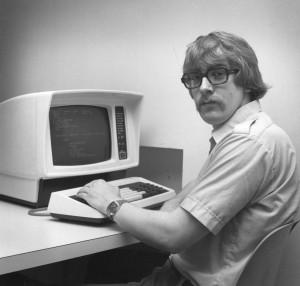Image

I retrieved another image from the "unidentified" box of photographs today in the Archives. This one really caught my attention, mainly because of the technology!
Can you identify this man?
Not only that, can you identify this computer? When was this cutting edge?
Tell us everything you can!

Comments
Ah! "Terminal" thank you Ted! Excellent information.
I think this is more likely from the early 1980's. I'm pretty sure the person in the picture is a grad student who worked for the computer center at the time. Based on that I think this was taken after the mainframe had moved from Amos Eaton to the VCC (in fall of 1979), but I do think this photo is from some room in Amos Eaton. I'd expect it's a room on the second floor.
Technically a 3270-ish terminal did not have any way to edit any files. It had to be connected to a IBM370-architecture mainframe, and it provided a way that the mainframe could put a variety of fields on the display. Some fields could be modified by the user, others could not. This was used to create a "visual mode" in the MTS editor, where the editor could read the modified fields from the terminal, and update a file based on those changes. But the terminal had no direct access to any files on the mainframe.
The "computer" is a Courier terminal which was a clone of an IBM 3270 terminal. It was connected to the mainframe, IBM 360/370. The photo was likely taken in the late '70s when RPI was moving from heavy reliance on Hollerith cards to "smart" terminals which could edit code locally on a page (typically 25 lines). The picture was likely taken in one of the terminal rooms on the first floor of Amos Eaton; the chair he's seated in really looks like something from Amos Eaton.
While the person in the photo looks familiar, I can't provide a name. He could have been one of the graduate students who worked as a consultant in Amos Eaton for those of us who had trouble with FORTRAN, other programming languages, or MTS (Michigan Terminal System).